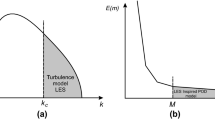Abstract
The reduced-order model (ROM) for the two-dimensional supersonic cavity flow based on proper orthogonal decomposition (POD) and Galerkin projection is investigated. Presently, popular ROMs in cavity flows are based on an isentropic assumption, valid only for flows at low or moderate Mach numbers. A new ROM is constructed involving primitive variables of the fully compressible Navier-Stokes (N-S) equations, which is suitable for flows at high Mach numbers. Compared with the direct numerical simulation (DNS) results, the proposed model predicts flow dynamics (e.g., dominant frequency and amplitude) accurately for supersonic cavity flows, and is robust. The comparison between the present transient flow fields and those of the DNS shows that the proposed ROM can capture self-sustained oscillations of a shear layer. In addition, the present model reduction method can be easily extended to other supersonic flows.
Similar content being viewed by others
References
Rowley, C. W. and Williams, D. R. Dynamics and control of high-Reynolds-number flow over open cavities. Annual Review of Fluid Mechanics, 38, 251–276 (2006)
Williams, D. R. and Rowley, C. W. Recent progress in closed-loop control of cavity tones. The 44th AIAA Aerospace Sciences Meeting and Exhibit, American Institute of Aeronautics and Astronautics, Reston (2006)
Cattafesta, L. N., Song, Q., Williams, D. R., Rowley, C. W., and Alvi, F. S. Active control of flow-induced cavity oscillations. The Progress in Aerospace Sciences, 44, 479–502 (2008)
Colonius, T., Basu, A. J., and Rowley, C.W. Numerical investigation of the flow past a cavity. The 5th AIAA/CEAS Aeroacoustics Conference, American Institute of Aeronautics and Astronautics, Reston (1999)
Rowley, C. W., Colonius, T., and Basu, A. J. On self-sustained oscillations in two-dimensional compressible flow over rectangular cavities. Journal of Fluid Mechanics, 455, 315–346 (2002)
Rubio, G., de Roeck, W., Baelmans, M., and Desmet, W. Numerical identification of flow-induced oscillation modes in rectangular cavities using large eddy simulation. International Journal for Numerical Methods in Fluids, 53, 851–866 (2007)
Gharib, M. and Roshko, A. The effect of flow oscillations on cavity drag. Journal of Fluid Mechanics, 177, 501–530 (1987)
Wan, Z. H., Zhou, L., and Sun, D. J. Numerical investigation of flow-induced oscillations and noise from a rectangular cavity (in Chinese). Acta Aerodynamica Sinica, 30(3), 291–298 (2012)
Zhang, C., Wan, Z. H., and Sun, D. J. Mode transition and oscillation suppression in supersonic cavity flow. Applied Mathematics and Mechanics (English Edition), 37(7), 941–956 (2016) DOI 10.1007/s10483-016-2095-9
Nagarajan, K. K., Cordier, L., and Airiau, C. Development and application of a reduced order model for the control of self-sustained instabilities in cavity flows. Communications in Computational Physics, 14, 186–218 (2013)
Rempfer, D. Low-dimensional modeling and numerical simulation of transition in simple shear flows. Annual Review of Fluid Mechanics, 35, 229–265 (2003)
Ukeiley, L., Cordier, L., Manceau, R., Delville, J., Glauser, M., and Bonnet, J. Examination of large-scale structures in a turbulent plane mixing layer, part 2, dynamical systems model. Journal of Fluid Mechanics, 441, 67–108 (2001)
Galletti, B., Bruneau, C., Zannetti, L., and Iollo, A. Low-order modelling of laminar flow regimes past a confined square cylinder. Journal of Fluid Mechanics, 503, 161–170 (2004)
Rowley, C.W., Colonius, T., and Murray, R. M. POD based models of self-sustained oscillations in the flow past an open cavity. The 6th AIAA/CEAS Aeroacoustics Conference, American Institute of Aeronautics and Astronautics, Reston (2000)
Rowley, C. W., Colonius, T., and Murray, R. M. Deynamical models for control of cavity oscillations. The 7th AIAA/CEAS Aeroacoustics Conference, American Institute of Aeronautics and Astronautics, Reston (2001)
Rowley, C. W., Colonius, T., and Murray, R. M. Model reduction for compressible flows using POD and Galerkin projection. Physica D: Nonlinear Phenomena, 189, 115–129 (2004)
Rowley, C. W. and Juttijudata, V. Model-based control and estimation of cavity flow oscillations. Proceedings of the 44th IEEE Conference on Decision and Control, and the European Control Conference 2005, Institute of Electrical and Electronics Engineers, Piscataway (2005)
Rowley, C. W., Juttijudata, V., and Williams, D. R. Cavity flow control simulations and experiments. The 43rd AIAA Aerospace Sciences Meeting and Exhibit, American Institute of Aeronautics and Astronautics, Reston (2005)
Caraballo, E., Yuan, X., Little, J., Debiasi, M., Yan, P., Serrani, A., Myatt, J. H. and Samimy, M. Feedback control of cavity flow using experimental based reduced order model. The 35th AIAA Fluid Dynamics Conference and Exhibit, American Institute of Aeronautics and Astronautics, Reston (2005)
Samimy, M., Debiasi, M., Caraballo, E., Serrani, A., Yuan, X., Little, J. and Myatt, J. Feedback control of subsonic cavity flows using reduced-order models. Journal of Fluid Mechanics, 579, 315–346 (2007)
Berkooz, G., Holmes, P., and Lumley, J. The proper orthogonal decomposition in the analysis of turbulent flows. Annual Review of Fluid Mechanics, 25, 539–575 (1993)
Sirovich, L. Turbulence and the dynamics of coherent structures. Quarterly of Applied Mathematics, 45(3), 561–590 (1987)
Fletcher, C. Computational Techniques for Fluid Dynamics, 2nd ed., Springer-Verlag, Berlin (1991)
Lumley, J. and Poje, A. Low-dimensional models for flows with density fluctuations. Physics of Fluids, 9(7), 2023–2031 (1997)
Kurganov, A. and Tadmor, E. New high-resolution central schemes for nonlinear conservation laws and convection-diffusion equations. Journal of Computational Physics, 160, 241–282 (2000)
Rossiter, J. E. Wind-tunnel experiments on the flow over rectangular cavities at subsonic and transonic speeds. Royal Aircraft Establishment Technical Report No. 64037, Royal Aircraft Establishment, Farnborough (1964)
Acknowledgements
In the DNS, the authors especially thank the OpenFOAM Foundation for the free, open source computational fluid dynamics software package OpenFOAM. The author Zhenhua WAN especially thanks the Fundamental Research Funds for the Central Universities.
Author information
Authors and Affiliations
Corresponding author
Additional information
Project supported by the National Natural Science Foundation of China (Nos. 11232011, 11402262, 11572314, and 11621202)
Rights and permissions
About this article
Cite this article
Zhang, C., Wan, Z. & Sun, D. Model reduction for supersonic cavity flow using proper orthogonal decomposition (POD) and Galerkin projection. Appl. Math. Mech.-Engl. Ed. 38, 723–736 (2017). https://doi.org/10.1007/s10483-017-2195-9
Received:
Revised:
Published:
Issue Date:
DOI: https://doi.org/10.1007/s10483-017-2195-9
Keywords
- supersonic cavity flow
- reduced-order model (ROM)
- proper orthogonal decomposition (POD)
- Galerkin projection




